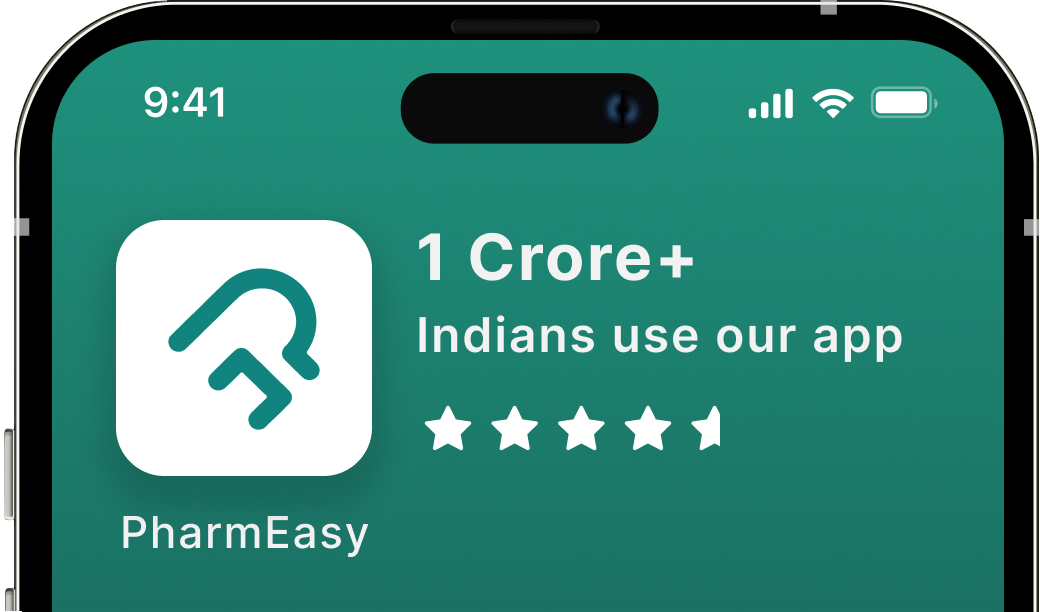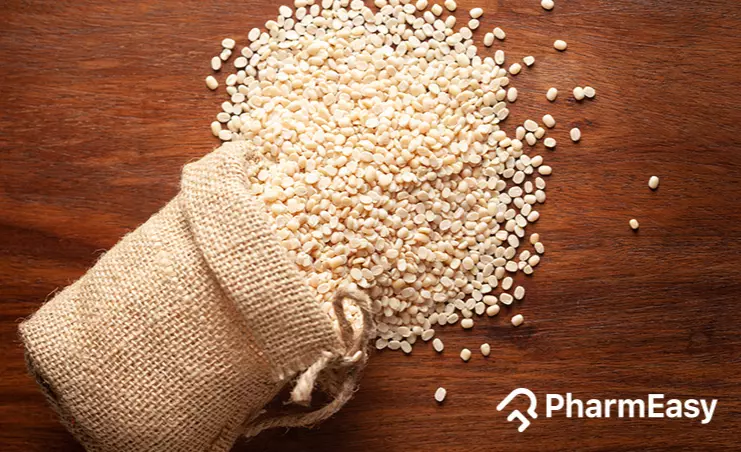Urad Dal: Uses, Benefits, Side Effects, and More!
By Dr Anuja Bodhare +2 more

Get,

to manage your symptom
Get your,


4 Cr+ families
benefitted

OTP sent to 9988776655



You’ve successfully subscribed to receive
doctor-approved tips on
Whatsapp

Get ready to feel your best.

Hi There,
Download the PharmEasy App now!!


Register to Avail the Offer
Send OTPBy continuing, you agree with our Privacy Policy and Terms and Conditions

Hi There,
Sign up on PharmEasy now!!
Trusted by 4 crore+ families

OTP sent to 9988776655



You have unlocked 25% off on medicines




Code: NU25
By Dr Anuja Bodhare +2 more
Table of Contents
Urad dal, scientifically called Vigna mungo, is a lentil most commonly used in South Indian households. It is also called Urd bean, Urad bean, Black lentil, Black matte bean, Mungo bean in English, and Urad dal in Hindi. Vigna mungo seeds are mainly a staple food, and the dehulled and split seeds (dhal in Hindi) are a typical dish in South Asia. It can be found in Asia, Madagascar, and Africa1. Vigna mungo is a hairy and bushy annual plant that has an elaborate taproot. The stem is highly branched from the base. The plant is cultivated for its edible seeds in tropical countries, especially in Asia2.

Black gram split (urad dal) and whole urad dal have tremendous nutritional value. Urad dal is a good source of proteins, carbohydrates, lipids, iron, and calcium. In addition, whole urad has dietary fibre, whereas urad dal (split urad) does not contain fibre. Among the phytochemicals, prominent phytochemicals present in urad dal are flavonoids and phenolic compounds.
The nutritional value table below is for 100 grams of urad dal, and the whole Urad is given below:
Nutritional value of urad dal (black gram split) per 100 grams3
Nutritional value of urad whole (black gram whole) per 100 grams
Vitamins like tocopherols are also present in black gram.
The seed coat of Urad contains various phytochemicals that may show many properties. Some of the properties of urad dal are mentioned below.
Regularly eating urad dal with a low-fat diet may help maintain lipid homeostasis (balance). As a result, it may help reduce the risk of heart disease. Agents responsible for this heart-friendly property of Urad dal are fibre, low glycemic index, and minor components like saponins, phytosterols, and oligosaccharides. Also, the lipids in black gram may show cholesterol-lowering effects in humans7. If you are suffering from heart disease, make sure you talk to your healthcare provider before using urad dal for its benefits.
Urad dal has a low glycemic index (increases blood glucose levels slowly). Along with a low glycemic index, it also has a high content of indigestible fibre, making it an excellent candidate for maintaining blood sugar levels in individuals with diabetes7. Also, black gram may help prevent insulin resistance associated with type 2 diabetes. Hence, black gram may be consumed to avoid type 2 diabetes. However, diabetes is a severe health condition that requires you to strictly adhere to the doctor’s advice. Avoid using urad dal or any herbal remedy to manage your symptoms without consulting a doctor first.
The presence of lipids, proteins, and fats lends black gram high nutritional value. In addition, black gram may help maintain a healthy body weight by providing early satiety due to its high fibre content, limiting overall food consumption7. However, if you are looking to reduce or manage weight, you can reach out to a dietitian or nutritionist, as they will be able to better guide you about the benefits and limitations of each diet.
Prebiotics are indigestible foods beneficial in stimulating the growth of helpful intestinal bacteria and improving overall gut health. Black grams are a good source of prebiotics. Consuming black grams (whole) may provide prebiotic health benefits and might be regarded as a potential functional food7.
In excess, reactive oxygen species (ROS) can damage cells like proteins, lipids, and DNA, resulting in conditions like cancer, neurodegenerative diseases, and atherosclerosis. Black grams are rich in polyphenols, which possess antioxidant properties. Polyphenols may prevent cellular damage caused by the presence of excessive ROS and thus protect from diseases caused by long-term and chronic inflammation7.
Urad dal may show liver-protective and kidney-protective properties. These properties might be due to components like phenolics, tannins, flavonoids, and phytic acid in urad. These components are potent antioxidants that may show a protective effect on the liver and kidneys7. However, if you are suffering from kidney or liver disease, you need to consult your healthcare provider before using urad dal or any other herbal remedy for kidney or liver problems.
Though studies show the benefits of urad dal in various conditions, these are insufficient, and there is a need for further studies to establish the true extent of the benefits of urad dal on human health.
Did you know that combining mung beans with cereals can greatly enhance the quality of protein in your diet? Cereals are rich in amino acids that contain sulfur, but they lack lysine, an essential amino acid. By pairing mung beans with cereals, you can create a complete protein source that provides all the necessary amino acids for your body’s needs.
Dr. Rajeev Singh, BAMS
There are several ways you can involve urad dal in your diet,
You must consult a qualified doctor before taking urad dal or herbal supplements. Likewise, do not discontinue or replace an ongoing modern medical treatment with an ayurvedic/herbal preparation without consulting a qualified doctor.
In my experience, I have found that mung beans can be an excellent protein source for individuals who prefer a vegetarian diet. Mung bean protein is not only cost-effective but also highly digestible compared to the protein found in other legumes. This means that your body can efficiently break down and absorb the nutrients from mung bean protein, providing you with the necessary building blocks for muscle growth and overall health.
Dr. Siddharth Gupta, B.A.M.S, M.D (Ayu)
Currently, no known side effects are associated with consuming urad dal in moderate quantities. However, if you experience any side effects after eating urad dal, you must consult a healthcare provider or doctor immediately.
Also, avoid using urad dal or other herbs to manage health conditions without consulting your healthcare provider. This will help you avoid unwanted side effects.
Also Read: Coconut Milk: Uses, Benefits, Side Effects and More!
Urad dal may be added as a food component in the diet. But while using any herbal product for its benefits, one must follow general precautions and eat it in moderation. Moreover, if you want to use urad dal for its properties or against any disease conditions, talk to your doctor first. It will help you make well-informed choices and avoid unwanted health effects.
Over the years, I have learned that in China and other Asian countries, the mung bean is recognised as a functional food with detoxifying properties. The specific mechanisms by which it achieves this detoxification are still being studied, but it is believed that the high fibre content and antioxidant compounds in mung beans help to eliminate toxins from the body and promote overall detoxification processes.
Dr. Smita Barode, BAMS, MS
There are no reported interactions of urad dal with other drugs and medicines. However, if you are taking medication for any health condition, you need to consult with your doctor about the possible interactions of the drug with other foods and herbs.
Also, you are advised not to use urad dal for any disease condition without a doctor’s consultation.
Also Read: Chandraprabha Vati (Chandraprabha Gulika): Uses, Benefits, Side Effects, Precautions & More!
Often overlooked and underestimated, urad dal is more than just a supporting ingredient in your meals. Right from supporting heart health and blood sugar control to improving digestion and offering antioxidant protection, it quietly does a lot of heavy lifting behind the scenes. Its versatility in Indian cooking makes it easy to include in everyday meals, and when consumed mindfully, it can be a smart ally for better health. However, if you’re dealing with specific health concerns, it’s best to discuss dietary changes with your doctor to ensure they align with your nutritional needs.
Also Read: Moong Dal: Uses, Benefits, Side Effects and More!
Black gram split is the English name for urad dal.
Urad dal possesses excellent antioxidant properties that make it beneficial for the heart, liver and kidneys. In addition, it has a low glycemic index and high dietary fibre content that may be helpful as a good food substance for patients with diabetes and those on weight control diets. However, consult your healthcare provider before using urad dal for any of its health benefits.
There are no reported major side effects of urad dal. Its seeds are edible and consumed as food. However, if you experience any side effects after consuming urad dal, immediately reach out to your healthcare provider.
Black grams may help in maintaining a healthy body weight by providing a satiety effect, which leads to limiting overall food consumption. So, it may be used to manage obesity. However, it is better to consult your healthcare provider or dietitian before discontinuing medication or making any dietary changes.
1. Black gram (Vigna mungo) | Feedipedia [Internet]. [cited 2022 Apr 6]. Available from: https://www.feedipedia.org/node/236
2. Vigna mungo – Useful Tropical Plants [Internet]. [cited 2022 Apr 6]. Available from: https://tropical.theferns.info/viewtropical.php?id=Vigna+mungo
3. Urad dal by DIYA. NutritionValue.org. [cited 2025 May 28]. Available from: https://www.nutritionvalue.org/Urad_dal_by_DIYA_593298_nutritional_value.html?size=100+g
4. Girish TK, Pratape VM, Prasada Rao UJS. Nutrient distribution, phenolic acid composition, antioxidant and alpha-glucosidase inhibitory potentials of black gram (Vigna mungo L.) and its milled by-products. Food Research International. 2012 Apr 1;46(1):370–7. Available from: https://www.sciencedirect.com/science/article/abs/pii/S0963996912000117
5. Swaroopa C, Kashmira L, Vikas G, Rajan W. Assessment of the prebiotic potential of seed coats from green gram (Vigna radiata) and black gram (Vigna mungo). Journal of Food Science and Technology 2021 59:2 [Internet]. 2021 Mar 3 [cited 2022 Apr 6];59(2):583–8. Available from: https://link.springer.com/article/10.1007/s13197-021-05043-2
6. Arockianathan PM, Rajalakshmi K, Nagappan P. Proximate composition, phytochemicals, minerals and antioxidant activities of Vigna mungo L. seed coat. Bioinformation. 2019 Aug 31 [cited 2025 May 28]. Available from: https://pmc.ncbi.nlm.nih.gov/articles/PMC6822517/
7. Swamy KRM. Origin, domestication, taxonomy, botanical description, genetics and cytogenetics, genetic diversity and breeding of urad bean (Vigna mungo (L.) Hepper). International Journal of Current Research. 2023 Aug 30 [cited 2025 May 28]. Available from: https://www.journalcra.com/sites/default/files/issue-pdf/45739.pdf
Disclaimer: The information provided here is for educational/awareness purposes only and is not intended to be a substitute for medical treatment by a healthcare professional and should not be relied upon to diagnose or treat any medical condition. The reader should consult a registered medical practitioner to determine the appropriateness of the information and before consuming any medication. PharmEasy does not provide any guarantee or warranty (express or implied) regarding the accuracy, adequacy, completeness, legality, reliability or usefulness of the information; and disclaims any liability arising thereof.
Comments

Leave your comment...
You may also like
Comments